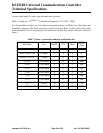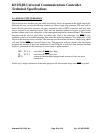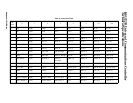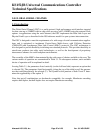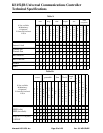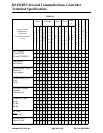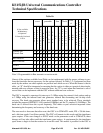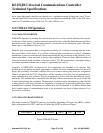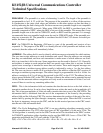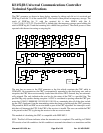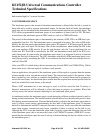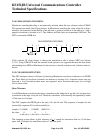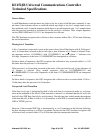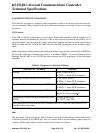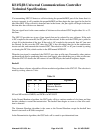
KS152JB Universal Communications Controller
Technical Specifications
Kawasaki LSI USA, Inc. Page 37 of 120 Ver. 0.9 KS152JB2
be in some other mode than the user intends for a significant amount of time after reset. To pre-
vent unwanted GSC errors from occurring, the user should not enable the GSC or the GSC inter-
rupts for 170 machine cycles ((256 X 8) /12) after LNI bit is set.
3.2 CSMA/CD Operation
3.2.1 CSMA/CD OVERVIEW
CSMA/CD Operates by sensing the transmission line for a carrier, which indicates link activity.
At the end of link activity, a station must wait a period of time, called the deference period, before
transmission may begin. The deference period is also known as the interframe space. The inter-
frame space is explained in Section 3.2.3
With this type of operation, there is always the possibility of a collision occurring after the defer-
ence period due to line delays. If a collision is detected after transmission is started, a jamming
mechanism is used to ensure that all stations monitoring the line are aware of the collision. A res-
olution algorithm is then executed to resolve the contention. There are three different modes of
collision resolution made available to the user on the C152. Re-transmission is attempted when a
resolution algorithm indicates that a station’s opportunity has arrived.
Normally, in CSMA/CD, re-transmission slot assignments are intended to be random. This
method gives all stations an equal opportunity to utilize the serial communication link but also
leaves the possibility of another collision due to two stations having the same slot assignment.
There is an option on the C152 which allows all the stations to have their slot assignments previ-
ously determined by user software. This pre-assignment of slots is called the deterministic resolu-
tion mode. This method allows resolution after the first collision and ensures the access of the link
to each station during the resolution. Deterministic resolution can be advantageous when the link
is being heavily used and collisions are frequently occurring and in real time applications where
determinism is required. Deterministic resolution may also be desirable if it is known before hand
that a certain station’s communication needs to be prioritized over those of other stations if it is
involved in a collision.
3.2.2 CSMA/CD FRAME FORMAT
The frame format in CSMA/CD consists of preamble, Beginning of Frame flag (BOF), address
field, information field, CRC, and End of Frame flag (EOF) as shown in Figure
Typical CSMA/CD Frame
PREAMBLE BOF ADDRESS INFO CRC EOF



